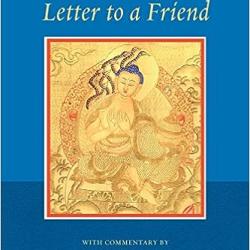Lojong is a set of techiniques for training the mind. These techniques are designed to open our hearts and awaken our minds. There are fifty nine slogans and they offer us a lot of help in transcending our egotism and putting down the baggage we are carrying.
The fifty nine slogans have been used by Tibetan Buddhists for centuries in order to help Buddhist practitioners focus on what’s important in our efforts to train and tame our minds. Sometimes on the Buddhist path we can tend to forget why we’re doing this and what’s important.
The important thing about these teachings is that they help us to meet ordinary situations in life with a Bodhisattva state of mind. Lojong really involves making our views more expansive, cultivating a compassion that includes everyone.
These teachings have been handed down for 8 centuries. Lojong is considered a Mahayana teaching. Vajrayana Buddhism has been so influential on the Buddhism of Tibet that Mahayana teachings sometimes get overlooked. As a practitioner of Mahayana Buddhism, I love delving into teachings like these.
Lojong practice helps me to transform all of the aspects of my life into the path of Enlightenment. It reminds me that there is no separation between the sacred life and ordinary life, between the spiritual and the worldly. It helps me to be less pulled around by my egotism. When we practice lojong even really difficult circumstances can become more workable.
Lojong practice is one of my teachers.
The Lojong slogans are said to come from the great Indian Buddhist teacher Atisha, who received extensive training in bodhicitta and mind training. A Tibetan student of Atisha’s founded the Kadam lineage of Tibetan Buddhism. Now Lojong practice is found in all of the major branches of Tibetan Buddhism.
Lojong is a list of 59 slogans that summarize the view and application of Mahayana Buddhism. They provide a way to train our minds through both meditation practice and daily life. The foundation, as with most Buddhist teachings, is on developing mindfulness and awareness.
With this practice we become more aware of how self-centered our worldview is. We practice to reverse that and have a broader vision, a vision of gentleness and fearless compassion. This way we begin to think of ourselves as part of the world, rather than making enemies of everything all the time. We want to prevent our actions and motivations from being quite so motivated by projections and expectations.
Our practice in ordinary life is based on learning these slogans and being able to remember them when we need them. If we study them diligently, we will find them coming into our minds when we need them.
Lojong teachings can inspire us to live with more gentleness and compassion. They inspire us to transcend the self.
Lojong practice can serve as our basic training on the path of the Bodhisattva.
The Lojong slogans are divided into seven categories. I’m going to write about each one as a series here.
I hope they mean as much to you as they do to me.
————————————————————————————
Daniel Scharpenburg is a meditation instructor and dharma teacher in Kansas City. He regularly gives teachings through the Open Heart Project, the largest virtual mindfulness community in the world.
Find out more about Daniel on his website and connect with him on Facebook.
You can support independent Buddhist writing by joining a community of fellow learners/practitioners at Patreon










